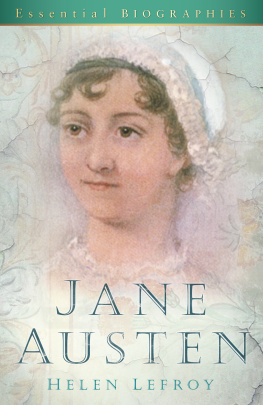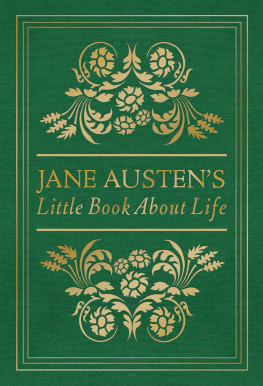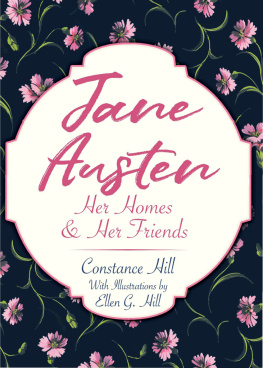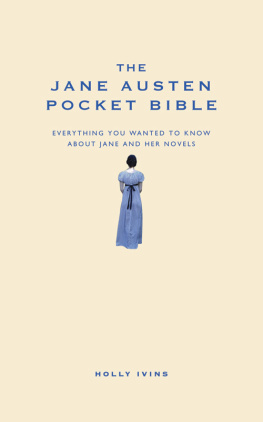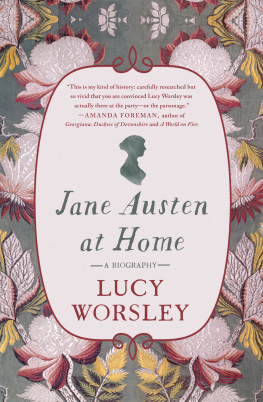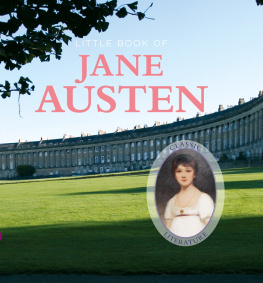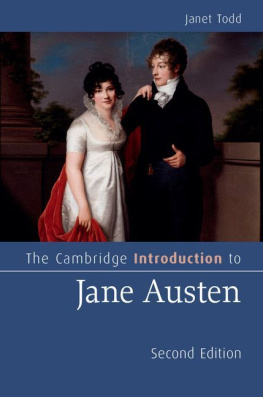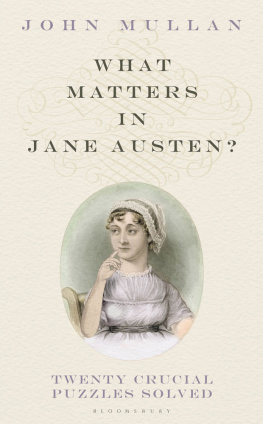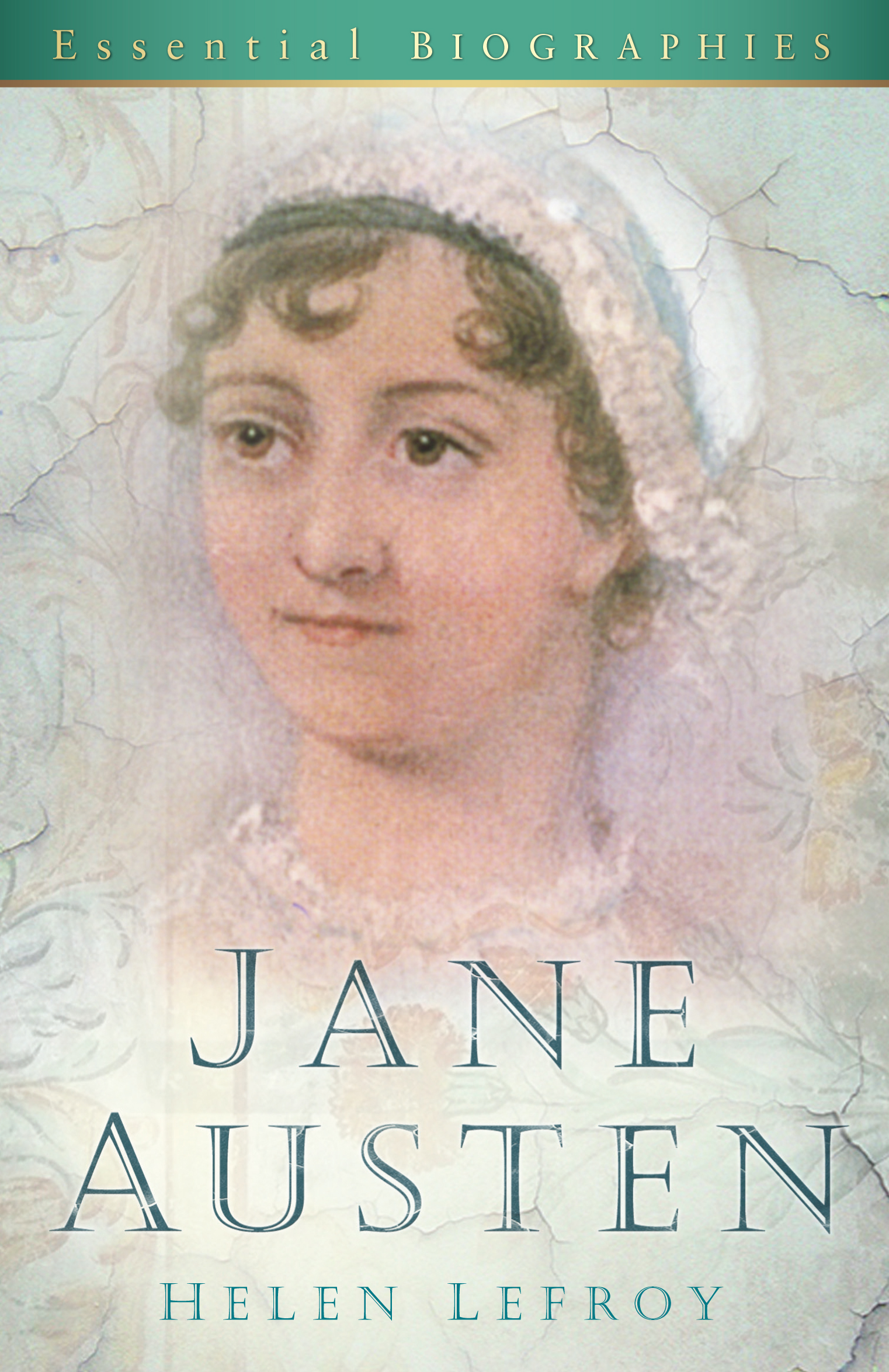Jane Austen
Jane Austen
HELEN LEFROY
First published 1997
Reprinted 1999
This edition published 2009
The History Press
The Mill, Brimscombe Port
Stroud, Gloucestershire, GL5 2QG
www.thehistorypress.co.uk
This ebook edition first published in 2011
All rights reserved
Helen Lefroy 1997, 1999, 2009, 2011
The right of Helen Lefroy, to be identified as the Author of this work has been asserted in accordance with the Copyrights, Designs and Patents Act 1988.
This ebook is copyright material and must not be copied, reproduced, transferred, distributed, leased, licensed or publicly performed or used in any way except as specifically permitted in writing by the publishers, as allowed under the terms and conditions under which it was purchased or as strictly permitted by applicable copyright law. Any unauthorised distribution or use of this text may be a direct infringement of the authors and publishers rights, and those responsible may be liable in law accordingly.
EPUB ISBN 978 0 7524 7402 1
MOBI ISBN 978 0 7524 7401 4
Original typesetting by The History Press
With gratitude for memories of Jane Austens great-great-nieces, my godmother Louisa Langlois Lefroy and her sisters, Cousin Jessie and Cousin Isabel
CONTENTS
CHRONOLOGY
1764 | The Revd George Austen and Cassandra Leigh married in Walcot Church, Bath |
1765 | James, their first child, born |
1766 | George, the handicapped son, born |
1767 | Edward born; he took the name Knight in 1812 |
1768 | The Austens move into Steventon Rectory |
1771 | Henry Thomas born |
1773 | Cassandra Elizabeth born |
1774 | Francis (Frank) William born |
1775 | 16 December, Jane born |
1779 | Charles John, the Austens last child, born |
1783 | Cassandra, Jane and their cousin Jane Cooper go to Mrs Cawley in Oxford for lessons |
17848 | Amateur dramatics at Steventon Rectory |
1785 | Cassandra and Jane join Jane Cooper at the Abbey School, Reading, but return home at the end of 1786 |
178793 | Jane busy writing stories and sketches |
1791 | Edward marries Elizabeth Bridges |
1792 | James marries Anne Mathew Cassandra becomes engaged to the Revd Tom Fowle |
1795 | Jamess wife Anne dies; his daughter Anna is taken to live at Steventon Rectory |
17956 | Tom Lefroy in Hampshire for Christmas and New Year Jane begins writing First Impressions, the first draft of Pride and Prejudice |
1797 | Mr Austen writes to a London publisher offering to send the manuscript of First Impressions; the offer is refused Tom Fowle dies of yellow fever in the West Indies |
1799 | Mrs Leigh Perrot (Mrs Austens sister-in-law) charged with larceny and committed to gaol |
1800 | Mrs Leigh Perrot tried and acquitted |
1801 | Mr and Mrs Austen, Cassandra and Jane move to Bath |
1802 | In December Harris Bigg Wither proposes to Jane; he is accepted but turned down next morning |
1803 | Copyright of Susan (Northanger Abbey) sold to publisher for 10 The Austens holiday in Lyme Regis |
1804 | The Austens have a second holiday in Lyme Regis |
1805 | Death of Mr Austen |
1806 | The Austens leave Bath, and after a round of visits join Frank and his bride in Southampton |
1809 | Mrs Austen, Cassandra, Jane and Martha Lloyd move to Chawton in Hampshire |
1811 | Jane at work on Mansfield Park Sense and Sensibility published |
1813 | Pride and Prejudice published |
1814 | Jane begins writing Emma Mansfield Park published |
1815 | Jane begins writing Persuasion Jane is invited to see round Carlton House, the Prince Regents London house, and to dedicate to him her next novel Emma published in December |
1816 | Henry negotiates purchase of manuscript of Susan from dilatory publisher; it is published posthumously as Northanger Abbey |
1817 | Jane begins writing Sanditon, but manuscript remains uncompleted In May Cassandra takes Jane to Winchester for medical help 18 July, Jane Austen dies; she is buried in Winchester Cathedral on 24 July December, Northanger Abbey and Persuasion published together in four volumes, with a Biographical Notice of the author by Henry Austen |
INTRODUCTION
Jane Austen (17751817) wrote only six complete novels, two of which were published after her death. In these novels the life of the gentry, landowners and clergy at the end of the eighteenth and the early part of the nineteenth centuries is shown in detail. They are peopled by an assembly of characters, men and women, old and young some, but not many, children who are unforgettable and can become as real to the reader as his or her own friends and family. Jane Austen did not step outside her own self-imposed limits. She does not write of titled people in grand houses although she knew the aristocratic families living in the corner of North Hampshire where she lived with her parents for her first twenty-five years, and as a young and attractive girl was invited to the annual balls given by titled families.
Critics accuse Jane Austen of being obsessed with money and rich relations. But both were a necessity in the society to which she belonged. As the younger daughter of a country parson she knew from an early age that without a dowry she would be unlikely to find a husband among her circle of friends. An eldest son would inherit the property and money to keep it together, or he might be lucky and marry a rich wife. What became of younger sons? They entered the church, the armed forces, and the law; not until later in the nineteenth century did they engage in trade. As benefices in the Church of England were largely privately owned or the property of university colleges, it was essential to know or be related to owners of advowsons and rectories. Twice Mr Austen sought to advance the careers of his two naval sons, both of them reliable, enthusiastic and thoroughly professional young officers, by invoking the help of friends in high places.
All Jane Austens work shows a recognizable standard of values. Her father was a country vicar; his family remained faithful Christians throughout their lives, and went regularly to church. Jane took for granted that a person should be sincere, unselfish, disinterested and unworldly, and that virtue should be judged by good sense and good taste. These beliefs are fundamental to her work. In

